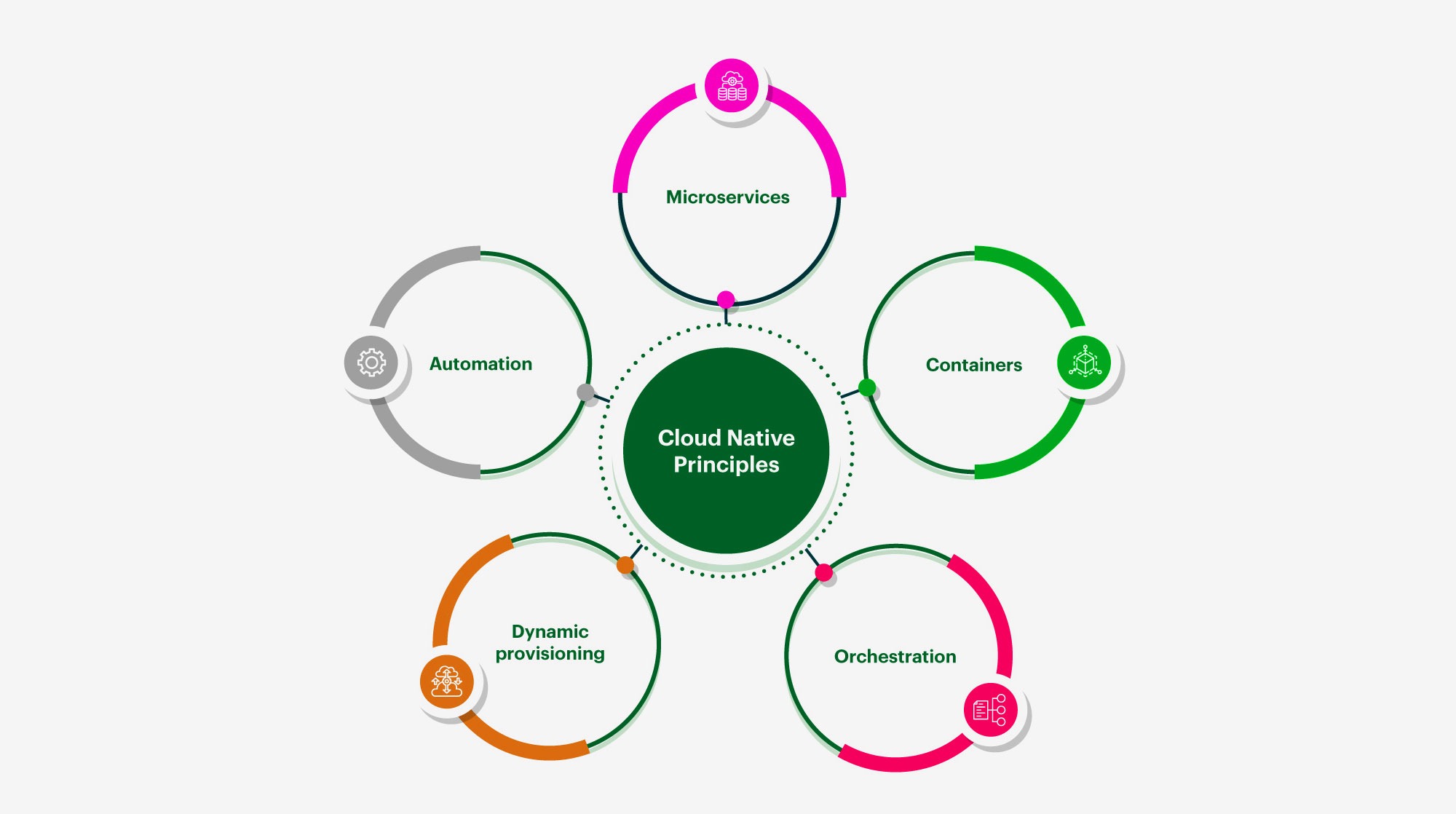Cloud Native Architecture: An Overview

In the ever-evolving landscape of technology, traditional approaches to software development and deployment are giving way to more dynamic and efficient solutions. One such groundbreaking approach is cloud-native architecture.
Before diving into details, the fundamental question of ‘what is cloud native architecture‘ needs to be answered. This innovative methodology has rapidly gained traction across industries due to its inherent advantages and transformative impact on the development and deployment of software applications. In this article, we’ll embark on a journey to understand what Cloud Native Architecture is, delve into its various benefits, explore its design principles and features, and even take a glance at the cloud computing landscape in India.
- Understanding Cloud-native Architecture
- Advantages Galore
- Designing for the Cloud
- Unveiling Key Features
- Guiding Principles
- Cloud Computing Landscape in India
- Navigating Security Challenges
- The Evolving Paradigm of Data Management
- Future-proofing with Cloud Native
- The Human Aspect: Cultivating a Cloud-native Culture
- Conclusion: Navigating the Cloud Native Path
Understanding Cloud-native Architecture
Imagine if software could be developed and deployed in a way that seamlessly leverages the limitless power of the cloud. That’s precisely what Cloud Native Architecture offers. It’s an approach that’s not just about where applications run but also how they are built and operated.
Cloud Native Architecture entails designing applications as a collection of smaller, interconnected microservices that can be independently developed, deployed, and scaled. These microservices are containerized to be easily moved between cloud environments without compatibility issues.
Advantages Galore
Unveiling the benefits
The benefits of Cloud-native architecture are as boundless as the cloud itself. One of the most notable advantages is scalability. Traditional monolithic applications often need help to handle sudden spikes in traffic. Cloud Native Architecture, however, allows you to scale individual microservices as required, ensuring optimal performance at all times. This results in cost savings and a smoother user experience. Additionally, the architecture’s inherent resilience ensures that if one microservice fails, the entire application doesn’t come crashing down.
Agility and speed
Cloud-native architecture features are such that they supercharge development cycles. By breaking down applications into smaller components, developers can work on different parts simultaneously, accelerating the development process. This agility extends to updates and fixes as well. With microservices, you can release updates to specific parts of an application without disrupting the entire system. This not only speeds up the delivery of new features but also allows for quicker bug fixes and security patches.
Designing for the Cloud
Creating software that thrives in a cloud-native environment requires a distinct mindset. Cloud-native architecture and design mean adopting a container-first approach. Containers encapsulate each microservice and its dependencies, ensuring consistent performance across domains. This design philosophy also promotes the use of declarative APIs, which define the desired state of an application without prescribing how to achieve it. This abstraction empowers the underlying system to make necessary adjustments, ensuring the application runs smoothly regardless of the underlying infrastructure.
Unveiling Key Features
Automation and DevOps culture
Automation lies at the heart of Cloud Native Architecture. The ability to automatically provision resources, manage deployments, and scale services based on demand is pivotal. This dovetails with the DevOps culture, fostering collaboration between development and operations teams. Automation streamlines workflows and reduces the likelihood of errors that often accompany manual interventions.
Dynamic orchestration
Orchestration is like conducting a symphony of microservices. Containers must be spun up, scaled, and shut down dynamically based on traffic and demand. Here comes Kubernetes, the star of the show. Kubernetes automates these tasks, ensuring your application runs reliably even in the face of ever-changing conditions.
Guiding Principles
To fully grasp the benefits of cloud-native architecture, it’s essential to delve into the principles that guide its design and implementation. Cloud-native architecture principles define the architecture’s core philosophy and provide a roadmap for building robust and scalable applications.
Let’s take a closer look at the three fundamental principles that underpin Cloud Native Architecture:
1. Microservices approach
At the heart of Cloud Native Architecture lies the concept of microservices. This principle advocates breaking down complex applications into smaller, self-contained components, each responsible for a specific business function. Unlike monolithic applications, where all functionalities are tightly interwoven, microservices offer modularity and flexibility. Each microservice can be developed, deployed, and maintained independently. This accelerates the development process and allows teams to focus on specific areas of expertise.
By adhering to the microservices approach, businesses can achieve better resource utilization. For instance, if a particular microservice experiences a surge in demand, only that specific component needs to be scaled rather than the entire application. Furthermore, this principle promotes polyglot programming, which enables developers to use different sets of programming languages and technologies based on their specific requirements.
2. Statelessness
In Cloud Native Architecture, statelessness is a guiding principle that carries significant weight. Statelessness means that microservices do not store persistent data. Instead, any necessary data or state is kept external to the microservices, typically in a database or other storage solutions. This principle is critical for achieving seamless scalability.
Stateless microservices allow for easy duplication and distribution. When a new instance of a microservice is needed due to increased demand, it can be rapidly created without concern for existing data. This design ensures that applications can be scaled up or down efficiently without worrying about data consistency or synchronization issues. Additionally, stateless microservices are more resilient to failures since they can be replaced without affecting the overall system.
3. Resilience
Failures are an inherent part of any system, and cloud-native architecture features embrace this reality with its resilience principle. Resilience involves designing applications to handle failures and disruptions gracefully. In a traditional monolithic setup, if one part of the application fails, it can bring down the entire system. Cloud Native Architecture, however, promotes a fail-fast and recover-quickly mindset.
Each microservice is designed to be autonomous and resilient.
If one microservice experiences a failure, it doesn’t necessarily disrupt the entire application. Other microservices can continue to function, and the failed microservice can be replaced or restored without affecting the overall performance. This principle reduces downtime and enhances the user experience. Moreover, it aligns with the dynamic nature of cloud environments, where instances and resources might be added or removed frequently.
Cloud Computing Landscape in India
As we explore the realm of Cloud Native Architecture, it’s interesting to note India’s thriving cloud computing ecosystem. The country is witnessing a surge in cloud computing companies, with names like CloudConnect, BuzzyBrains, and E2E Networks making their mark. These cloud computing companies in India offer a range of services, from infrastructure provisioning to platform solutions.
While discussing India’s tech landscape, the burgeoning scene of custom software development is worth mentioning. Companies like CodeCrafters and BuzzyBrains are exemplars of this trend. They specialize in crafting tailored software solutions that perfectly align with the unique needs of businesses.
Navigating Security Challenges
In the world of cloud-native applications, security is paramount. The architecture’s distributed nature and reliance on microservices introduce new challenges. Traditional security measures might need to be revised. However, Cloud Native Architecture offers solutions too. Zero Trust Security is gaining traction, focusing on authenticating and authorizing every interaction, regardless of location or network. This approach, combined with Micro-segmentation, ensures that the potential damage is limited even if a breach occurs.
The Evolving Paradigm of Data Management
Cloud Native Architecture profoundly impacts how organizations manage their data. Traditional databases often need help to keep up with the speed and scale of modern applications. Here, cloud-native databases step in. These databases are purpose-built for dynamic cloud environments, offering features like auto-scaling and automatic backups. This evolution is particularly beneficial for businesses dealing with large amounts of data.
Future-proofing with Cloud Native
The tech landscape is ever-evolving, and future-proofing is essential. Cloud Native Architecture provides a solid foundation for staying relevant in the face of change. Its modular structure allows businesses to adopt new technologies and services seamlessly. For instance, integrating machine learning into a specific microservice becomes more accessible. This adaptability ensures that companies can continuously innovate without overhauling their entire architecture.
The Human Aspect: Cultivating a Cloud-native Culture
Transitioning to Cloud Native Architecture isn’t just about technology; it’s also a cultural shift. Teams must embrace collaboration and a willingness to experiment. Communication becomes paramount as crews work on different parts of an application simultaneously. The move to cloud-native often prompts the adoption of Agile methodologies and Continuous Integration/Continuous Deployment (CI/CD) practices. This cultural shift can lead to more empowered teams, quicker innovation, and better alignment between development and business goals.
Conclusion: Navigating the Cloud Native Path
In the dynamic world of software development, Cloud Native Architecture stands out as a game-changer. Its benefits are manifold, from enhanced scalability and agility to improved resilience and automation. By adhering to its design principles, businesses can unlock new levels of efficiency and innovation. As the cloud computing scene in India flourishes, the adoption of Cloud Native Architecture is poised to reshape how software is conceptualized, developed, and deployed.
Companies like BuzzyBrains are at the forefront of this evolution, leading the charge toward a more streamlined and dynamic software landscape. It is among the top custom software development company in India, catering to various business needs.
Technology never stands still, and embracing the cloud-native approach might be the key to staying ahead in this digital marathon. So, as you navigate the ever-evolving tech terrain, consider the transformative potential of Cloud Native Architecture. Your software, your business, and your innovation can all soar to new heights in the embrace of the cloud.

